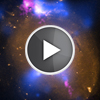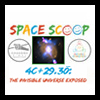CXC Home | Search | Help | Image Use Policy | Latest Images | Privacy | Accessibility | Glossary | Q&A
Tour of 4C+29.30
Quicktime MPEG With closed-captions (at YouTube)
Astronomers think that just about every galaxy contains a giant, or supermassive, black hole at their center. Sometimes the intense gravity of these black holes can be tapped to produce intense power. That's what is happening in the galaxy known as 4C+29.30, which is found some 850 million light years from Earth. By looking at this galaxy with different telescopes, astronomers can get a more complete picture. Radio data show two jets of particles that are speeding at millions of miles per hour away from the supermassive black hole. X-rays from Chandra trace the location of hot gas in the galaxy. The bright X-rays in the center of the image mark a pool of million-degree gas around the black hole. Some of this material may eventually be consumed by the black hole, and the magnetized, whirlpool of gas near the black hole could, in turn, trigger more output to the radio jet. Most of the low-energy X-rays around the black hole are absorbed by dust and gas, which is probably in the shape of a giant doughnut around the black hole. This doughnut, or torus, blocks all the optical light produced near the black hole, so astronomers refer to this type of source as a hidden or buried black hole.
[Runtime: 01:36]
Quicktime MPEG With closed-captions (at YouTube)
Astronomers think that just about every galaxy contains a giant, or supermassive, black hole at their center. Sometimes the intense gravity of these black holes can be tapped to produce intense power. That's what is happening in the galaxy known as 4C+29.30, which is found some 850 million light years from Earth. By looking at this galaxy with different telescopes, astronomers can get a more complete picture. Radio data show two jets of particles that are speeding at millions of miles per hour away from the supermassive black hole. X-rays from Chandra trace the location of hot gas in the galaxy. The bright X-rays in the center of the image mark a pool of million-degree gas around the black hole. Some of this material may eventually be consumed by the black hole, and the magnetized, whirlpool of gas near the black hole could, in turn, trigger more output to the radio jet. Most of the low-energy X-rays around the black hole are absorbed by dust and gas, which is probably in the shape of a giant doughnut around the black hole. This doughnut, or torus, blocks all the optical light produced near the black hole, so astronomers refer to this type of source as a hidden or buried black hole.
[Runtime: 01:36]
(Credit: NASA/CXC/J. DePasquale)
The Invisible Universe Exposed
Quicktime MPEG With closed-captions (at YouTube)
Pictures of space are often gorgeous. But one of the most exciting things about them is that, very often, they show us things that are invisible to the human eye. This picture in particular does that. In the middle of the photograph lurks an invisible monster, called a super-massive black hole To make this invisible object even harder to study, it is hidden under a thick cloud of dust at the centre of its home galaxy! Even the bright blobs of colour you can see are patches of light that our eyes cannot detect naturally. The pink colour shows radio light, and X-rays are shown in blue.
A black hole is anything but empty space, don't let the name fool you. It is a huge amount of material packed into a very tiny area - this one has about 100 million times the mass of our Sun! Anything that wanders too close to a Black Hole is pulled into it with no chance of escape, including light. This is why we cannot see black holes, they are invisible even to telescopes that detect X-rays, radio waves and other types of light.
The only way we can spot black holes is by detecting its effect on other things. For example, in this picture, the brightest blue patches, along the edge of the galaxy reveal where a high-energy jet has ploughed into clumps of galactic dust. The jet was made up of particles that were heated as they were pulled into the black hole. This gave them energy and sent them speeding away from the black hole at millions of miles per hour! Two similar jets can be seen in pink, shooting to the North and South of the galaxy.
[Runtime: 02:12]
Quicktime MPEG With closed-captions (at YouTube)
Pictures of space are often gorgeous. But one of the most exciting things about them is that, very often, they show us things that are invisible to the human eye. This picture in particular does that. In the middle of the photograph lurks an invisible monster, called a super-massive black hole To make this invisible object even harder to study, it is hidden under a thick cloud of dust at the centre of its home galaxy! Even the bright blobs of colour you can see are patches of light that our eyes cannot detect naturally. The pink colour shows radio light, and X-rays are shown in blue.
A black hole is anything but empty space, don't let the name fool you. It is a huge amount of material packed into a very tiny area - this one has about 100 million times the mass of our Sun! Anything that wanders too close to a Black Hole is pulled into it with no chance of escape, including light. This is why we cannot see black holes, they are invisible even to telescopes that detect X-rays, radio waves and other types of light.
The only way we can spot black holes is by detecting its effect on other things. For example, in this picture, the brightest blue patches, along the edge of the galaxy reveal where a high-energy jet has ploughed into clumps of galactic dust. The jet was made up of particles that were heated as they were pulled into the black hole. This gave them energy and sent them speeding away from the black hole at millions of miles per hour! Two similar jets can be seen in pink, shooting to the North and South of the galaxy.
[Runtime: 02:12]
(Credit: NASA/CXC/April Jubett)
Return to 4C+29.30 (May 15, 2013)




